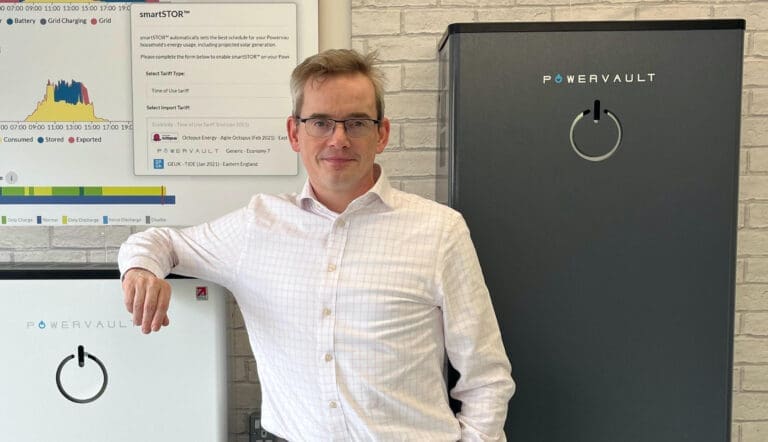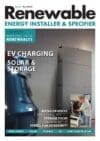
Here we talk with Robin about what drew him to join this British green energy tech company and to hear his thoughts on the current energy storage market, the future direction for the company and how energy management software and ‘time-of-use’ tariffs are set to deliver exponential growth in the domestic sector for renewable energy storage solutions.
Robin, please give us a little of your background before joining Powervault
Before joining Powervault late last year I was at James Fisher and Sons, the marine engineering business, where we were very focused on supporting the energy transition. Before that I was at Spectris, the high-tech instruments and equipment company. I’m an engineer by training – I started at Rolls Royce – and I’m convinced that technology has a vital role in decarbonising the energy market. I’ve worked in many corporate roles in industrial and technology businesses, often during periods of change and growth – I like pulling things together and making them work. In my corporate roles I have invested in many small innovative technology businesses, helping them fulfil their potential.
How did the role with Powervault come about and why is it the right move for you?
“Be part of the solution” is an idea which means a huge amount at Powervault. That’s what really brought me here. Powervault is a terrific business, it has the pioneering green energy technology and culture to play a meaningful role in transforming the way people use energy. I have the skills, passion and network to grow technology businesses. But there is still work to do. We need to make sure people know about our high-quality solar batteries and unique software like SMARTSTOR, keep designing great products, and keep building our UK-based customer service.
Give us an overview of the UK domestic energy storage market, highlighting the key drivers and what you consider to be the tipping points for uptake.
We’re at a tipping point right now. Electricity prices have increased significantly over the last five years so people are looking for more savings on their bills. The price of solar batteries is coming down and they are getting better, more reliable and easier to install – all of which is great for installers.
Time-of-use tariffs and energy management software are opening up further savings. It all makes storage more attractive, whether it’s retrofit or new installations. There are already nearly 1.5 million homes with solar panels in the UK – consumer interest in green tech is getting stronger and stronger.
Give us a little on the background and evolution of Powervault since its launch in 2014.
Powervault started in the days when people were putting solar panels on their roofs and getting paid by the government for exporting electricity back into the grid under the feed in tariff scheme. We realised that you could store excess solar electricity at home in a battery. Our very first prototype used lead-acid car batteries from Halfords and a simple control system.
Obviously we have come a long way since then, moving to lithium ion batteries, enhancing our controls, and adding a portal for customers to understand their energy usage and most recently adding AI technology. All those years of really learning how batteries work, how they need to be controlled, seeing what other manufacturers are doing – that bedrock understanding allows us to provide customers with robust solutions and really supportive customer service.
Powervault is a specialist in smart storage solutions. What do these add to the drive for energy efficiency, reduced consumption and the transition away from fossil fuels?
Solar panels, time-of-use tariffs and batteries all offer huge potential for saving money and using greener electricity. The magic happens when you get them working together effectively, and that’s where the energy management software comes in.
Our AI software, SMARTSTOR, learns your individual energy usage patterns, constantly scans the weather forecast, and knows your tariff, so that it can make daily decisions about how much cheap energy from the grid to store and how much battery capacity to leave available for your free surplus solar generation.
We think it’s a game changer that really resonates with users. This technology can also help shift the load away from the peak grid use time of 4:00 – 8:00pm.
When lots of people do this, more and more off peak renewable energy will be used, this enables the grid to work more effectively and help the transition to net zero.
You have indicated your enthusiasm for working with entrepreneurial leaders, building the best teams and helping teammates to fulfil their potential. What are you hoping to bring to Powervault and what will success look like for you?
Everybody has more impact when they are a valued member of a winning team on a worthwhile mission. My job is to make that happen: to help teams align on a clear goal and take the actions to reach that place. Success will be lowering energy bills for a lot of people around the world, and reducing their carbon footprint. It means new products, new technology and new sales channels.
Talking about teams, we’re spending a lot of time extending our installer network – we want to make their installation jobs faster and simpler. One advantage we have is that we’re UK-based so can talk to installers easily and help to resolve issues. We think it’s right that we take responsibility for our products by supporting installation with full training and advice for installers, and that we directly resolve any customer questions and concerns and that we support the warranty directly.
We’re launching a new hybrid inverter right now, meaning our batteries can be installed alongside new solar panel installations, not just as retrofits. We’re looking forward to expanding our range further soon, we can’t say much now but think the market will find it exciting. We are working with a few installers we know well to make sure it’s a big success.
Domestic storage solutions are strongly associated with solar installations. Is there an argument for installing storage solutions in the absence of solar?
Yes, the reasons for installing batteries, even if you don’t have solar, are getting stronger. It’s becoming easier to make the most of new time- of-use tariffs, by combining them with batteries, so that you buy energy at the cheaper prices and store it for when you need it. Batteries are becoming cheaper and better.
Tell us about compatibility across the domestic renewables industry.
Are manufacturers collaborating to ensure different elements can be combined easily by installers to deliver optimal solutions for customers?
At Powervault we have worked to make our product work alongside other products in the green tech ecosystem, and with energy tariffs from a number of different suppliers. Some installers like to use systems from the same supplier, but we hope to convince them to choose best of breed products instead. We can help by providing customers and installers with advice about how to set things up to work well together.
How much impact has the scrapping of VAT on energy storage systems had on uptake? What additional changes would you like to see in legislation, funding or certification that you believe would facilitate far more rapid domestic energy decarbonisation?
We spearheaded a campaign to scrap VAT on storage retrofit and were delighted when the government made that decision. It aligned storage retrofit with the rest of the market, and unlocked a pent-up demand. The resulting lower price should give a sustainable boost to the market. We have worked hard with our installer network to ensure that those savings are passed through to customers.
Other changes that would be welcome? We are a long-standing campaigner for new legislation to facilitate energy storage and unlock the significant CO2 reduction benefits it can bring. It has often been a struggle to get distribution network operators to permit connection of all forms of clean energy technology to the grid – but we all know that batteries help the network because they store unwanted generation and use it to reduce peak demand.
There is still more that the Government, Ofgem and DNOs could do to make it easier to connect batteries and unlock CO2 benefits.
What does 2024 hold for Powervault?
Right now we’re getting ready to launch the Powervault P5, our new solar battery, which we think installers are really going to like. In addition to the hybrid inverter, it’s IP65-rated for outdoor installation and has modular all-in-one construction, ranging from 5kWh up to 20kWh. It’s easy to install, competitively priced and we think users will love the slimmer aesthetic finish.
We’re aiming to launch the P5 in the summer. In order to make sure it delights installers and customers from the outset, we’re currently in the midst of a rigorous testing programme, and are working with a few installers we know well to make sure it’s a big success.
Alongside the P5, we’ll also be launching our new subscription service, which will incorporate the benefits of SMARTSTOR and several exciting new features. These will make it even easier for Powervault to manage customer support over the lifetime of the battery.
We’re looking forward to talking to installers about it all at Solar & Storage Live, together with some other new products which we’ll be unveiling there.
What do you believe the future holds for installers of domestic renewable energy systems – what will be the hottest solutions?
The future is exciting because the underlying market continues to grow through the growing demand for electricity and drive to net zero.
There will be innovative alternatives to lithium ion, algorithms to optimise storage cycling will improve, and EV batteries will become part of the mix. The installation market is very competitive at the moment, but as customer awareness grows there will be a shake out.
The installers who thrive most will be those who give good advice to customers, a quick response, adapt to changing technology and provide safe installation.
Image credit: Powervault




